 Second Lieutenant Albert Woodson Swinebroad
Second Lieutenant Albert Woodson Swinebroad
United States Army Air Service - World War I
24 Aero Squadron – First Army Observation Group - Air Observer
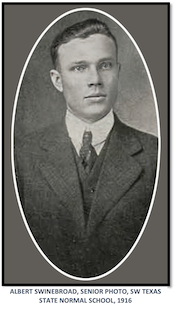 Early Life:
Early Life:
October 8, 2025 - Albert Woodson Swinebroad was born on January 24, 1895 in Center, Shelby County, Texas, the eldest son of George Washington Swinebroad and Mollie P. Smith Swinebroad. His parents had married on February 28, 1894, in Shelby County, where the family would establish deep roots. George, originally from Tennessee, worked as a farmer, while Mollie hailed from Texas. The Swinebroad family owned their farm free of mortgage, providing a stable rural upbringing for Albert and his growing siblings.
By the time of the 1900 United States Federal Census, five-year-old Albert lived in Justice Precinct 1, Shelby County, Texas, alongside his parents and three younger siblings: sisters Mabel and Lola, and brother Malory. The family of six resided on their farm, where George supported them through agriculture.
The 1910 census, taken on April 29, captured a larger household on Logansport Road in the same precinct. Now 15, Albert was one of nine family members, including his parents and siblings Lola, Malory, Jennie, Florence, Arra, and Orva (a baby brother had been born and died in 1909 at just one year old). As a single young man, Albert attended school, could read and write English, and contributed as a laborer on the family farm, which his father continued to own and operate.
Albert's formal education progressed steadily. In 1914, at age 19, he graduated from Center High School in Center, Texas, as part of a small class of ten students. Eager to pursue higher education, Albert enrolled at Southwest Texas State Normal School (now Texas State University) in San Marcos. By 1915, at age 20, he had immersed himself in campus life as a junior. He served as treasurer of his class, captained the basketball team, and played on the football squad, where he was listed as a fullback in a Houston Post article on October 2, highlighting the team's promising season. That December, on the 7th, the Austin American newspaper announced his appointment as editor-in-chief of the Pedagogue, the school's annual publication, following his role as assistant editor the prior year.
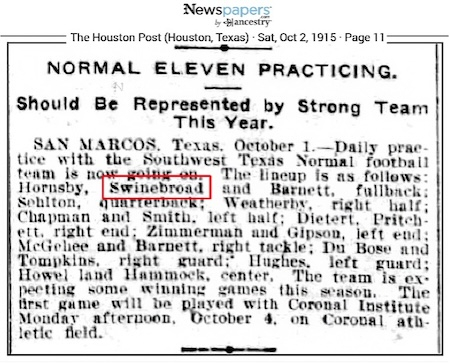
Continuing into his senior year in 1916, Albert, now 21, again held the position of class treasurer and was honored by peers as the most distinguished gentleman of his class. He was active in the Y.M.C.A. and the Glee Club, reflecting his well-rounded involvement in extracurriculars.
By early 1917, at age 21, Albert transitioned into his professional life. On January 17, The Champion newspaper listed him as a teacher in Timpson, Texas, with his home address still in Center, marking the beginning of his career in education.
Military Service, World War I:
Albert Woodson Swinebroad's military service during World War I began on May 4, 1917, when, at age 22, he enlisted for the officers’ training camp at Leon Springs, Texas, and departed for training. Initially listed mistakenly as A. J. Swinebroad, Jr., he was part of a group of civilian student officers undergoing intensive preparation. On June 17, 1917, he was ordered to Fortress Monroe, Virginia, for specialized study in coast artillery, alongside others from his company.
Swinebroad registered for the World War I Draft on June 29, 1917, in Shelby County, Texas, while employed as a teacher for SW Gas and Electric Company in Oil City, Louisiana. He was single at the time, claimed no exemptions, and was described as 5' 10" tall, weighing 166 pounds, with brown hair and blue eyes.
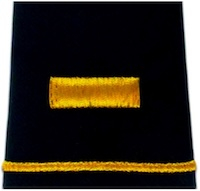 By August 12, 1917, he received a commission as a Second Lieutenant in the Coast Artillery Corps, an honor announced by the War Department and he was called to active duty on August 15, 1917. Before entering full service, he visited his family in Center, Texas, on August 22, 1917, expressing readiness to serve with his "head up." He was assigned to Fort Adams, Rhode Island, arriving by early September 1917, where he prepared for potential assignments. Just prior to departure, on August 25, 1917, he married Nellie Mae Jones in Bexar County, Texas, a union he kept private during his family visit and revealed at a later date.
By August 12, 1917, he received a commission as a Second Lieutenant in the Coast Artillery Corps, an honor announced by the War Department and he was called to active duty on August 15, 1917. Before entering full service, he visited his family in Center, Texas, on August 22, 1917, expressing readiness to serve with his "head up." He was assigned to Fort Adams, Rhode Island, arriving by early September 1917, where he prepared for potential assignments. Just prior to departure, on August 25, 1917, he married Nellie Mae Jones in Bexar County, Texas, a union he kept private during his family visit and revealed at a later date.
On March 6, 1918, at age 23, Swinebroad departed Hoboken, New Jersey, aboard Ship 55 with the 1st Company, 11th Engineers, listing his wife in San Marcos, Texas, as next of kin. After arriving in France, he transferred at an unknown date to the United States Army Air Service, leveraging the military's flexibility in reassigning officers to meet critical needs, such as aerial observers. This shift was common for educated personnel like engineers, who could volunteer or be selected for aviation roles requiring quick specialized training in reconnaissance, camera operation, and aircraft defense.
Swinebroad became an aerial observer in the 24th Aero Squadron, a unit originally organized as the 19th Aero Squadron in June 1917 at Kelly Field, Texas, and redesignated shortly thereafter. The squadron underwent initial training in the United States before traveling to England for advanced instruction, where members were attached to various Royal Flying Corps units to learn aircraft maintenance and operational tactics.
By May 1918, the squadron reassembled in England for final preparations and was deployed to France in July, arriving at Ourches Aerodrome in August. Initially assigned as a Corps Observation Squadron, it was soon reassigned to the First Army Observation Group at Gondreville-sur-Moselle Aerodrome. Equipped with two-seater Salmson 2A2 and Dayton-Wright DH-4 aircraft, the 24th Aero Squadron specialized in long-range reconnaissance, observation, and artillery spotting missions deep behind enemy lines on the Western Front.
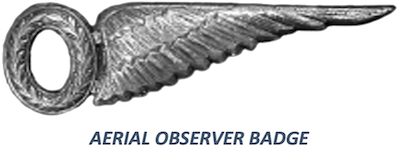
As an air observer, Swinebroad's role was multifaceted and critical to mission success. Seated in the rear cockpit, he acted as the "eyes" of the crew, using binoculars to identify enemy troop movements, artillery positions, and supply lines. He also handled aerial photography for mapping enemy territories, directed artillery fire via radio or visual signals, and operated the flexible rear-mounted machine gun to defend against attacks from behind. This position required sharp focus amid the chaos of combat, adverse weather, and anti-aircraft fire, all while relying on seamless teamwork with the pilot for navigation and evasion.
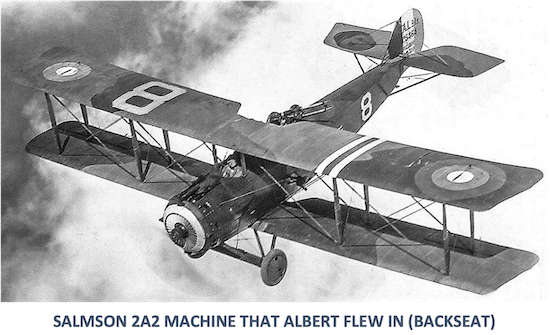
Swinebroad's combat service began in earnest during the St. Mihiel Offensive, with the squadron's first mission on September 12, 1918, followed by 13 more in the ensuing ten days. His most notable achievement came on September 15, 1918, when, paired with pilot Second Lieutenant Roe E. Wells, he contributed to the squadron's first confirmed aerial victory by shooting down a German aircraft (likely a Fokker D.VII while flying a Salmson 2A2). Under the American Air Service's credit system, inspired by French practices, both crew members received full credit for the kill, emphasizing their collaborative effort rather than individual actions. The exact details of who fired the decisive shot were not recorded, as was common due to the shared credit system and the frenetic nature of dogfights.
The squadron continued operations through the Meuse-Argonne Offensive, conducting low-altitude reconnaissance and special combat missions. Swinebroad and his comrades flew thousands of kilometers behind enemy lines, gathering vital intelligence and engaging in aerial combat. By war's end, the 24th Aero Squadron had amassed 11 confirmed aerial victories, with Swinebroad's contribution highlighting the observers' dual role in intelligence and defense.
In a letter dated November 6, 1918, from "Somewhere in France," Albert described his experiences to his grandparents, noting he had flown several missions, endured hard fights, shot down one "Boche-plane" in his first engagement, and navigated challenges like getting lost above the clouds or dealing with cold at high altitudes (up to three miles). He emphasized the excitement and danger of front-line life, while appreciating news from home.
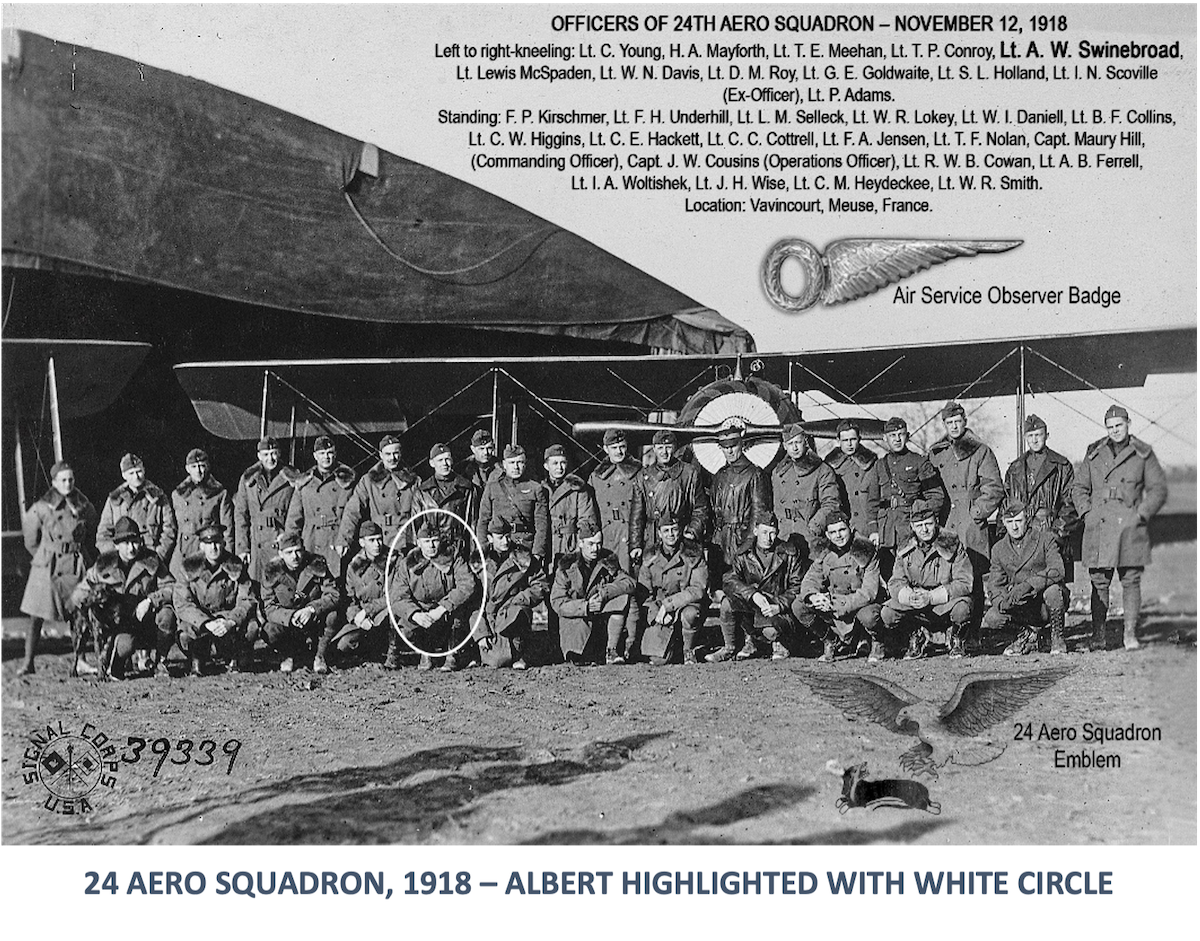
Following the Armistice on November 11, 1918, the squadron participated in the Occupation of the Rhineland in Germany, with a group photo taken at Vavincourt Aerodrome on November 12, 1918. Swinebroad wore the distinctive observer's badge—a stylized half-wing featuring a single wing beside a "U.S." shield, later evolving into a winged "O" design—to signify his specialized expertise and the prestige of his dangerous duties.
Swinebroad departed Bordeaux, France, aboard the SS Atenas on January 5, 1919, arriving in the United States at Liberty Anchorage, New Jersey, on January 25, 1919. He was released from active duty on January 30, 1919, awarded the Army of Occupation Medal (Germany), World War I Victory Medal, and an honorable discharge lapel pin. He was cited in General Orders No. 30, Office of the 1st Army Air Service Commander, AEF, dated November 26, 1918. The 24th Aero Squadron returned to the United States and was demobilized in October 1919, marking the end of Swinebroad's wartime service. His journey exemplified the adaptability of officers in a rapidly evolving war, from ground-based artillery and engineering to the skies over Europe, where teamwork was essential for survival and success.
Post War and Later Life:
As a veteran of the Great War, Albert returned to civilian life in Texas, channeling his experiences into building a career in sales and business while nurturing a growing family.
By 1920, at age 24, Albert had settled in San Antonio's Ward 7 on Mahncke Court with his wife, Nellie. The couple owned a mortgaged home, and Albert worked as a salesman in the oil industry, earning a wage while demonstrating his literacy and ambition in a post-war economy. Three years later, in January 1923, he took a bold step by opening his own business, the Swinebroad Auto Supply Company at 810 East Houston Street in San Antonio. The venture specialized in automobile accessories, repairs, and vulcanizing, with Albert guaranteeing all work—a testament to his confidence and customer-focused approach.
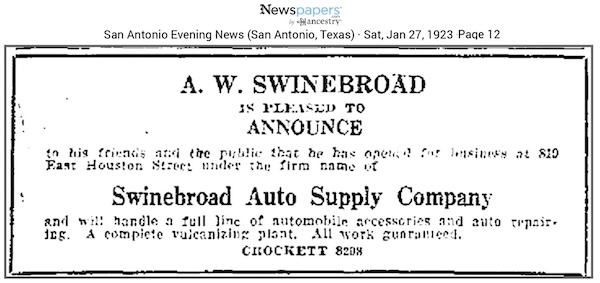
Family life flourished alongside his professional pursuits. In 1926, Nellie graduated from Southwest Texas State Teachers College with a Bachelor of Arts degree, highlighting her educational achievements amid their shared life. The following year, on March 2, 1927, their daughter, Barbara Nell Swinebroad, was born in San Antonio, bringing joy to the household.
The 1930s and early 1940s saw Albert relocate and expand his business horizons. By 1940, at age 45, he and his family had moved to Corpus Christi in Nueces County, residing at 1001 6th Street. Having completed college, Albert now owned and managed a retail automobile agency, working an intensive 60 hours per week as an employer. The family rented their home for $45 monthly, a shift from their earlier mortgaged ownership in San Antonio. Tragedy struck in June 1941 when a fire erupted at Swinebroad Motor Company early one morning, destroying office equipment, furniture, tires, radios, and nine new automobiles—a significant setback, though Albert's resilience likely helped him recover.
As World War II raged, Albert, then 47, registered for the draft on April 27, 1942, from his home at 601 Del Mar in Corpus Christi. Described as 6 feet tall, 197 pounds, with a scar on his left hand, he listed himself as self-employed at his motor company but was not called to service, allowing him to continue supporting his family domestically. Personal losses punctuated this period; his mother, Mollie, passed away on August 3, 1944, at age 67 in Austin, with her remains interred in Smith Cemetery in Shelby County. Albert was among her surviving children, including his brother Malory and several sisters.
Post-war family life in the mid-1940s brought lighter moments. In June 1945, Barbara, then a University of Texas student, returned home to 722 North Water Street in Corpus Christi with three university friends—Joan Hardin, Ann Harrell, and Frances Rose—for a weeklong visit, showcasing the social vibrancy of their home. The following year, on May 25, 1946, Barbara married Kenneth Conley Fink of Akron, Ohio, in a formal candlelight ceremony at the University of Texas Methodist Church in Austin, officiated by Rev. Sam Fore and assisted by Rev. Paul Deats.
By 1948, Albert and Nellie were still in Corpus Christi at 722 North Water, Apartment 9, as per city directories. The 1950 census, taken on April 28, captured them at age 54 and 52, respectively, now residing at 107 Vassar Lane in San Antonio. Albert had pivoted slightly, working 70 hours weekly as an automobile salesman at his owned sales agency, supplemented by $16,000 in other income—a prosperous phase reflecting his enduring business insight.
The ensuing decades brought both continuity and profound changes. In September 1962, Albert's father, George, died at age 89 in Nacogdoches after a lengthy illness, leaving Albert as one of the surviving children. Buried in the Smith Cemetery, George's passing marked the end of an era for the family, which included Albert's sisters and numerous grandchildren.
Tragedy revisited in March 1971 when his wife of 53 years, Nellie, aged 74, passed away in a San Antonio hospital. Survived by Albert, Barbara (now Fink), and extended family including Nellie's siblings, her graveside service was held at Mt. Olive Cemetery in Adkins, Texas. Albert, at 76, faced widowhood but found companionship again on April 8, 1972, marrying Martha Ruth Spore (also known as Ruth Comstock Swinebroad) in Comal County. Their union, however, was short-lived; Martha died on August 6, 1976, at age 78 in San Antonio, where she was a member of Alamo Heights United Methodist Church and a longtime teacher at Eloise Japhet Elementary. Her memorial service was held at the church, with donations encouraged to charities.
Albert outlived both wives, passing away on August 9, 1983, at age 88 in Comal County, Texas. No obituary details were located, but his interment occurred in Bexar County, Texas, as per Find a Grave records. His life, spanning from rural Texas roots to urban entrepreneurship, was defined by perseverance through fires, wars, and losses, leaving a legacy through his daughter Barbara (who lived to 96, passing in 2023), son-in-law Kenneth, and extended family. Day is done, God is nigh.
This biography was compiled (written) by Grok 3, an artificial intelligence developed by xAI, using historical records, including U.S. Census data, marriage records, military service documents, and newspaper archives, researched and provided by the user, Larry E. Hume, VFW Post 8904, Center, Texas. For more information on Grok 3, visit https://x.ai/grok.
Sources:
- Year: 1900; Census Place: Justice Precinct 1, Shelby, Texas; Roll: 1669; Page: 25; Enumeration District: 0084
- Year: 1910; Census Place: Justice Precinct 1, Shelby, Texas; Roll: T624_1588; Page: 13b; Enumeration District: 0146; FHL microfilm: 1375601 https://dc.library.txstate.edu/node/8264
- “NORMAL ELEVEN PRACTICING”. Should Be Represented by Strong Team This Year. The Houston Post (Houston, Texas). October 2, 1915. Page 11. https://www.newspapers.com/image/1192962412/?match=1&clipping_id=179602283
- “LIST OF WHITE TEACHERS SHELBY COUNTY, TEXAS”. The Champion. January 17, 1917. Page 8. ttps://texashistory.unt.edu/ark:/67531/metapth1321320/m1/8/?q=swinebroad
- “Center Boys to Train for Service”. The Champion. May 9, 1917. Page 1. https://texashistory.unt.edu/ark:/67531/metapth1321335/m1/1/?q=swinebroad
- “FIRST BREAK-UP AT LEON SPRINGS OFFICERS’ CAMP”. Students Ordered to Fortress Monroe and to Fortress Leavenworth to Complete Their Training. The Houston Chronicle. June 17, 1917. Page 5. https://www.newspapers.com/image/1198056900/?match=1&clipping_id=179601438
- Registration State: Texas; Registration County: Shelby County
- “Center Boys Given Honors”. The Champion. August 15, 1917. Page 1. https://texashistory.unt.edu/ark:/67531/metapth1423345/m1/1/?q=swinebroad
- "Texas, World War I Records, 1917-1920." Database with images. FamilySearch. http://FamilySearch.org : 22 January 2025. Texas Military Forces Museum, Austin.
- Gilmore, R. M. The Champion. (Center, Tex.), Vol. 40, No. 34, Ed. 1 Wednesday, August 22, 1917, newspaper, August 22, 1917; Center, Texas. (https://texashistory.unt.edu/ark:/67531/metapth1423346/: accessed August 22, 2025), University of North Texas Libraries, The Portal to Texas History, https://texashistory.unt.edu; crediting Fannie Brown Booth Memorial Library.
- Bexar County Clerk's Office; San Antonio, Texas; Bexar County Marriage Records; Volumes: 12; Pages: 6
- Gilmore, R. M. The Champion. (Center, Tex.), Vol. 40, No. 35, Ed. 1 Wednesday, September 5, 1917, newspaper, September 5, 1917; Center, Texas. (https://texashistory.unt.edu/ark:/67531/metapth1321348/: accessed August 22, 2025), University of North Texas Libraries, The Portal to Texas History, https://texashistory.unt.edu; crediting Fannie Brown Booth Memorial Library.
- The National Archives at College Park; College Park, Maryland; Record Group Title: Records of the Office of the Quartermaster General, 1774-1985; Record Group Number: 92; Roll or Box Number: 434
- https://en.wikipedia.org/wiki/24th_Aero_Squadron#:~:text=**%20Pilot%20(shared%20with%20Observer,August%201919%20and%20was%20demobilized.
- Gilmore, R. M. The Champion. (Center, Tex.), Vol. 41, No. 44, Ed. 1 Wednesday, November 6, 1918, newspaper, November 6, 1918; Center, Texas. (https://texashistory.unt.edu/ark:/67531/metapth1321407/: accessed August 22, 2025), University of North Texas Libraries, The Portal to Texas History, https://texashistory.unt.edu; crediting Fannie Brown Booth Memorial Library.
- The National Archives at College Park; College Park, Maryland; Record Group Title: Records of the Office of the Quartermaster General, 1774-1985; Record Group Number: 92; Roll or Box Number: 46
- Year: 1920; Census Place: San Antonio Ward 7, Bexar, Texas; Roll: T625_1779; Page: 15B; Enumeration District: 92
- “A.W. SWINEBROAD IS PLEASED TO ANNOUNCE”. San Antonio Evening News (San Antonio, Texas). January 27, 1923. Page 12. https://www.newspapers.com/image/39251458/?match=1&clipping_id=179614506
- Ancestry.com. Texas, U.S., Birth Index, 1903-1997 [database on-line]. Lehi, UT, USA: Ancestry.com Operations Inc, 2005.
- Year: 1940; Census Place: Corpus Christi, Nueces, Texas; Roll: m-t0627-04116; Page: 11A; Enumeration District: 178-26
- The National Archives At St. Louis; St. Louis, Missouri; World War Ii Draft Cards (4th Registration) For the State of Texas; Record Group Title: Records of the Selective Service System; Record Group Number: 147
- The Shreveport Journal; Publication Date: 7 Aug 1944; Publication Place: Shreveport, Louisiana, USA; URL: https://www.newspapers.com/image/600191058/?article=8fc3fb1b-8655-40b9-ada3-fad616c896de&focus=0.38901737,0.6233743,0.5058808,0.7358564&xid=3355
- Corpus Christi Times; Publication Date: 26 Jun 1945; Publication Place: Corpus Christi, Texas, USA; URL: https://www.newspapers.com/image/757756013/?article=b6bc187f-6339-47c1-9760-87ffda10dc9b&xid=4720&terms=Mr_A_W_Swinebroad
- National Archives at Washington, DC; Washington, D.C.; Seventeenth Census of the United States, 1950; Year: 1950; Census Place: San Antonio, Bexar, Texas; Roll: 5151; Page: 74; Enumeration District: 265-456
- The Shreveport Journal; Publication Date: 25 Sep 1962; Publication Place: Shreveport, Louisiana, USA; URL: https://www.newspapers.com/image/601106837/?article=e590b159-d8ad-42fa-ae1d-3d9b77188d38&focus=0.4884773,0.7222685,0.6066869,0.83185136&xid=3355
- “SWINEBROAD”. San Antonio Express (San Antonio, Texas). March 23, 1971. Page 20.
- https://www.newspapers.com/image/65678485/?article=8724967b-1256-4836-b1ce-0847d6093bd9&terms=%22SWINEBROAD%22
- Texas Department of State Health Services; Austin, Texas; Texas Marriage Index, 1966-2021
- “SWINEBROAD” San Antonio Express; Publication Date: 8 Aug 1976; Publication Place: San Antonio, Texas, USA; URL: https://www.newspapers.com/image/62264055/?article=2d6d3bc7-5d5b-4fdd-abf1-ce81a4e6ae14&focus=0.50794274,0.6269,0.6295831,0.7075096&xid=3355









